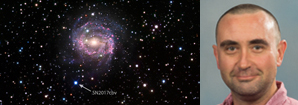New Faculty Member Dave Sand Tries to Find Supernovae As They Explode

Due to their roughly similar brightness, type Ia supernovae are vital for measuring distances and understanding dark energy in the Universe. Despite their utility, it is still not clear by what mechanism the white dwarf is pushed over the edge to explode -- it could be the inspiral of two white dwarfs losing gravitational energy, or a relatively normal star feeding the white dwarf until it becomes unstable. Observations by Dr. Dave Sand and his team have recently caught a very young type Ia supernova in the act of exploding, and the light curve reveals a 'blue bump'-- a long predicted, but never before seen, signature of the second scenario. This bump in the light curve is expected if the supernova ejecta crashes into a normal companion star, causing the envelop of the star to become shock heated and to emit some extra radiation that manifests itself as the extra 'bump' in the supernova light curve. Sand and his team have designed a supernova search exactly for this task, and these are the initial results of the program. You can find the UA press release HERE.
Dr. Sand was a Chandra Fellow postdoctoral scholar at Steward until about seven years ago, and after a second postdoctoral fellowship at Harvard & LCOGT, followed by a faculty position at Texas Tech, rejoined us as a faculty member on August 14.

For Public
Public events include our Monday Night Lecture Series, world-reknowned Astronomy Camp and Mt Lemmon Sky Center.

For Students
A good place to start if you want to become an undergrad major or grad student, or need to find our schedule of classes.

For Scientists
Find telescopes and instruments, telescope time applications, staff and mountain contacts, and faculty and staff scientific interests.




